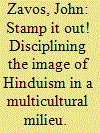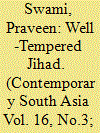|
|
|
Sort Order |
|
|
|
Items / Page
|
|
|
|
|
|
|
| Srl | Item |
| 1 |
ID:
083051


|
|
|
|
|
| Publication |
2008.
|
| Summary/Abstract |
The present paper explores the importance of new burial practices within the process of nation-building in the Sri Lankan territories controlled by the Liberation Tigers of Tamil Eelam (LTTE). In particular, the paper focuses on the perception that Tamil people, both civilians and fighters, seem to have of the Tigers' cemeteries as symbolic centres of Tamil Eelam, the new separate state claimed by the LTTE. This article analyses the reasons that have led to this perception. On the one hand, it discusses the functional analogies between the LTTE cemeteries and the war graveyards belonging to military western traditions. On the other hand, it emphasizes the peculiarity of the LTTE cemeteries of being perceived as holy places. The Tigers' cemeteries are called Tuilum Illam, literally in Tamil 'Sleeping Houses', and are often described as temples. The paper offers an explanation why the LTTE, in spite of their asserted secular nature, have decided not to reject this religious interpretation; namely, because it allows them to include the Tuilum Illam in the mainstream of Hindu tradition. In this context, the ability to integrate the religious dimension represents a crucial component in the process of nation-building. This article draws upon the findings of fieldwork carried out since July 2002, especially in the northeastern regions of Sri Lanka controlled by the LTTE.
|
|
|
|
|
|
|
|
|
|
|
|
|
|
|
|
| 2 |
ID:
083050


|
|
|
|
|
| Publication |
2008.
|
| Summary/Abstract |
From the 1950s up to the early 1990s the All-India data show an ever-declining share of informal credit in the total outstanding debt of rural households. Contemporaneous micro-level studies, using more qualitative research methodologies, provide evidence that questions the strength of this trend, and more recent All-India credit surveys show, first, a levelling, and then a rise, in the share of rural informal credit in 1990/91 and 2000/01, respectively. By reference to findings of a study of village moneylenders in Rajasthan, the paper notes lessons to be drawn. First, informal financial agents have not disappeared from the rural financial landscape in India. Second, formal-sector financial institutions can learn much about rural financial service needs from the financial products and processes of their informal counterparts. Third, a national survey of informal agents, similar to that of the 1921 Census survey of indigenous bankers and moneylenders, would provide valuable pointers towards policy options for the sector. A recent Reserve Bank of India Report on Moneylender Legislation not only explores incentive mechanisms to better ensure fair practice, but also proposes provision for a new category of loan providers that would explicitly link the rural informal and formal financial sectors
|
|
|
|
|
|
|
|
|
|
|
|
|
|
|
|
| 3 |
ID:
083054


|
|
|
|
|
| Publication |
2008.
|
| Summary/Abstract |
The present research note is based on the results of a survey conducted among the tsunami-affected communities in different regions of Sri Lanka-east, north and south (the former two are conflict-affected regions). The paper also compares and contrasts tsunami recovery efforts in other affected countries such as India and Indonesia. The major findings of the survey are that the outreach of relief has been good, that the government, donors and the civil society have not sufficiently adhered to the five cardinal principles they had agreed upon for tsunami reconstruction and recovery process in Sri Lanka, and it appears that Sri Lanka lags behind India but ahead of Indonesia in terms of quantity and quality of tsunami assistance to victims. The study also enunciates a set of proposals to improve the performance in the remaining reconstruction and recovery work to be undertaken in Sri Lanka
|
|
|
|
|
|
|
|
|
|
|
|
|
|
|
|
| 4 |
ID:
083053


|
|
|
|
|
| Publication |
2008.
|
| Summary/Abstract |
In November 2005 the UK Royal Mail's use of Hindu imagery in its Christmas stamp set was vigorously opposed by a range of organisations projected as representative of Hindus in the United Kingdom. The 'Hindu stamp' affair highlighted the speed with which appropriate institutional resources can now be mobilised to discipline the image of Hinduism as a religion in the name of a British Hindu community. It is one of a succession of such campaigns over the past few years, all directed towards regulating the representation of Hindu-ness in commercial, media and state institutions. In this paper I want to ask what function is served by this regulatory practice, and why has it become more prominent in recent years? What can the development of such practices tell us about the location of Hindu-ness as a minority ethnic identity, and the way in which this identity uses or contests broader regulatory practices related to the construction of ethnic identities in Britain? By examining the contexts and tracing the emergence of 'Hindu campaigning' in Britain, this paper argues that such mobilisations signal a significant stage in the rapid development of religion as a feature of contemporary British politics.
|
|
|
|
|
|
|
|
|
|
|
|
|
|
|
|
| 5 |
ID:
083052


|
|
|
|
|
| Publication |
2008.
|
| Summary/Abstract |
The present paper seeks to provide a detailed overview of new Islamist terror groups that have emerged across India. Operating outside Jammu and Kashmir, these groups are in the main made up of Indian nationals. Since 2001, when violence in Jammu and Kashmir began to decline, these new groups have engaged in a sustained campaign of terrorism through India. Operating with the infrastructural assistance of Pakistan-based and Bangladesh-based organisations like the Lashkar-e-Taiba and the Harkat ul-Jihad-e-Islami, the groups wage what might be described as a 'Well-Tempered Jihad': a campaign that keeps up Islamist pressure on the Indian state, whilst stopping short of inducing a major crisis involving the region's nation-states. The paper explores the relationship of this new jihad with state and non-state actors both in India and Pakistan, and argues that their growth has been driven by political circumstances in both countries.
|
|
|
|
|
|
|
|
|
|
|
|
|
|
|
|
|
|
|
|
|